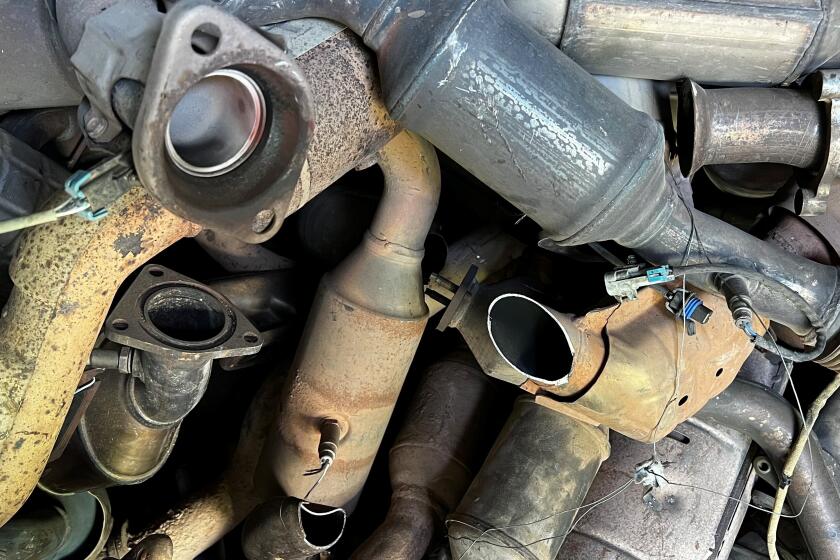California’s new setup a hurdle for Democrats’ bid to retake House
- Share via
California’s new elections system and redrawn political maps have surprisingly combined to forge a rockier path for Democrats hoping to win back a majority in Congress this fall.
In Tuesday’s primary, Democrats failed to secure a general election slot in one place they were counting on because of a changing voter pool — an Inland Empire district where the contest will instead feature two Republicans.
The maps and the “top two” rule, in wide use for the first time, produced at least six other same-party House contests and yielded a November ballot slot for a wealthy independent in a coastal Los Angeles County district.
Most prominent of the same-party contests on the fall ballot will be the high-spending, widely watched battle between veteran Democratic Reps. Brad Sherman and Howard Berman in a newly drawn San Fernando Valley congressional district. Sherman bested Berman 42% to 32% on Tuesday despite being substantially outspent by a so-called Super PAC independent fundraising group supporting Berman and by the Berman campaign itself. Five other candidates finished far back.
“We ran a bare-bones campaign in the primary,” Sherman said in a statement. “That was the exhibition game. Now we’re on to the real game, and our team is ready to go.”
Berman, whose current district overlaps far less of the new district than does Sherman’s, said he had concentrated on making it through the primary. Under the new rules, only the first- and second-place primary finishers, regardless of party affiliation, advance to the fall election.
“We always knew this was going to be a tough fight,” Berman said in a statement, “and our campaign will have the resources to take on my opponent and his dismal record.”
In another same-party race, Rep. Janice Hahn of San Pedro piled up a 20-percentage-point margin over fellow Democratic Rep. Laura Richardson, who decided to seek reelection in the newly drawn district rather than stay in neighboring Long Beach.
They were the only two candidates on the ballot and Richardson, who is under investigation by the House Ethics Committee for allegedly using her congressional staff for campaign work, has her work cut out for her. The district was created under the federal Voting Rights Act to foster the election of an African American. Hahn is white and Richardson is black.
A Republican-versus-Republican matchup in the Inland Empire was a big disappointment for Democrats, who were hoping that Redlands Mayor Pete Aguilar would land a place on the November ballot. Instead, Rep. Gary Miller of Diamond Bar, who switched districts to avoid a showdown with fellow Republican Rep. Ed Royce of Fullerton, will face off against state Sen. Bob Dutton of Rancho Cucamonga.
Democrats had hoped to position themselves in California to pick up as many as six of the 25 seats needed to win back the House majority from Republicans. The Democratic Congressional Campaign Committee stuck to its four- to six-seat projection Wednesday, but others said that would be tough to achieve. And the National Republican Congressional Committee called its Democratic counterpart “delusional.”
“A political freak accident” is how David Wasserman, who analyzes House races for the nonpartisan Cook Political Report, described the Inland Empire race. “This was one of the Democrats’ best opportunities to pick up a seat from Republicans, and overnight it became a safe Republican seat.”
“Democrats have work to do in the state if they are going to continue to maintain that they have a realistic chance of taking back the House,” Stuart Rothenberg, publisher of the nonpartisan Rothenberg Political Report, wrote on Wednesday.
A 13-candidate race in a solidly Republican inland district of mountains and desert remained close Wednesday as local elections officials began tallying remaining mail-in and provisional ballots. Only a handful of votes separated the four top finishers, three Republicans and a Democrat.
In a largely affluent, coastal Los Angeles County district, Bill Bloomfield, a deep-pocketed Manhattan Beach businessman, spent about $1 million to secure a place over six other hopefuls in the fall race against Rep. Henry Waxman (D-Beverly Hills). One of the few nonpartisan candidates in the state to win a spot in the November election, Bloomfield was formerly a longtime Republican who supported GOP candidates and causes. Waxman, who took 46% of the vote to Bloomfield’s 25%, is favored to win the strongly Democratic district in the fall.
Voters had earlier approved abolishing party primaries for congressional and state legislative races and had put the once-a-decade redistricting task in the hands of a citizens commission rather than politicians in hopes of producing more competitive races and more moderate lawmakers. Experts say it will take a while before it can be discerned whether that will happen.
“It will take a few cycles to see if this system will moderate the politics of who is winning elections,” said San Francisco-based Democratic political consultant Jim Ross. “But for now my answer would have to be no, I don’t think we will see a group of raging moderates heading to D.C. from California.”
But the changes had an immediate bearing on a number of House races Tuesday and helped reshape the fall battlegrounds.
Highly competitive races include a Ventura County district in which state Assemblywoman Julia Brownley (D-Oak Park) fended off Ventura County Supervisor Linda Parks, running as an independent, to take on Republican state Sen. Tony Strickland of Moorpark in the fall, and a seat in Riverside County, where Republican county Supervisor John Tavaglione will face Democrat Mark Takano, a community college board member.
But Democrats will have to defend one of their previously safe seats — in the recently reconfigured Central Coast district now represented by Rep. Lois Capps of Santa Barbara. She will face former Lt. Gov. Abel Maldonado of Santa Maria, who handily bested an independent candidate and another, more conservative Republican to win a place on the Nov. 6 ballot.
More to Read
Sign up for Essential California
The most important California stories and recommendations in your inbox every morning.
You may occasionally receive promotional content from the Los Angeles Times.











